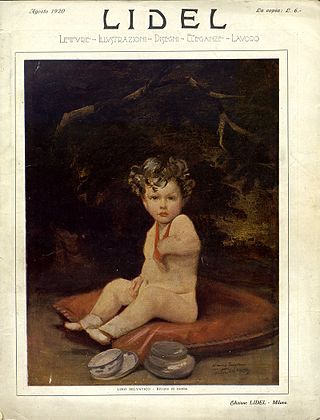
Grazia Maria Cosima Damiana Deledda, also known in Sardinian language as Gràssia or Gràtzia Deledda, was an Italian writer who received the Nobel Prize for Literature in 1926 "for her idealistically inspired writings which with plastic clarity picture the life on her native island [i.e. Sardinia] and with depth and sympathy deal with human problems in general". She was the first Italian woman to receive the prize, and only the second woman in general after Selma Lagerlöf was awarded hers in 1909.

Grazia is a weekly women's magazine that originated in Italy with international editions printed in Albania, Argentina, Australia, Bahrain, Bulgaria, China, Croatia, Colombia, France, Germany. Greece, Indonesia, India, Jordan, Macedonia, Mexico, the Netherlands, Poland, Portugal, Pakistan, Qatar, Serbia, Slovenia, South Korea, Spain, Thailand, and the United Kingdom.

Oggi is an Italian weekly news magazine published in Milan, Italy. Founded in 1939 it is one of the oldest magazines in the country.

Brunella Gasperini, pen name of Bianca Robecchi was an Italian journalist and novelist.

Epoca was an illustrated weekly current events magazine published between 1950 and 1997 in Milan, Italy. It was one of the leading magazines during its run.

Tempo was an illustrated weekly news magazine published in Milan, Italy, between 1939 and 1976 with a temporary interruption during World War II.
Novella 2000 is a weekly celebrity and women's magazine published in Milan, Italy. Founded in 1919, it is one of the oldest publications in the country. It is also one of the most read and well-known Italian gossip magazines.
Candido was a satirical magazine published in Milan, Italy, between 1945 and 1961. It was cofounded and edited by Giovannino Guareschi.
Noi donne is a monthly feminist magazine published in Rome, Italy. It is one of the most significant feminist publications in the country.
Anna was a weekly women's fashion magazine based in Milan, Italy. It was in circulation in 1984 and 2013.
Graziella Sonnino Carpi was an Italian feminist and peace activist in the interwar period. She was a member of the Italian Unione Femminile Nazionale and a delegate to the 1919 Women's Conference.
Vie Nuove was a weekly popular magazine published in Rome, Italy, between 1946 and 1978. The magazine was one of the post-war publications of the Italian Communist Party which used it to attract larger sections of the population.
Omnibus was a weekly illustrated general cultural magazine published in Milan, Italy, between 1937 and 1939. Its subtitle was settimanale di attualità politica e letteraria. It is described as the "father of Italian magazines", especially in regard to the use of photographs and images. The magazine was closed by the fascist authorities.
Il Selvaggio was a political and arts magazine that existed between 1924 and 1943. It was a media outlet of an intellectual group called Strapaese.
Il Travaso delle idee, mostly known as Il Travaso, was a satirical magazine which was in circulation between 1900 and 1966 with an interruption in the period 1944–1946. Its subtitle was Organo ufficiale delle persone intelligenti. The magazine was headquartered in Rome, Italy.

Lidel was a nationalist women's fashion magazine which was in circulation Milan, Italy, in the period 1919–1935. The title was a reference to its founder's name, Lydia Dosio De Liguoro, as well as to the words Letture, illustrazioni, disegni, eleganze, lavori. The magazine played a significant role in the birth of Italian fashion, but at the same time became one of the most militant publications of Fascist Italy.
Asso di bastoni was a weekly satirical and political magazine which was headquartered in Rome, Italy. It was in circulation between 1948 and 1957. The magazine was the organ of the Repubblica Sociale Italiana which was established by the members of the Italian Social Movement, a neo-fascist political party.
Eva was a weekly women's magazine which was published between 1933 and 1968 in Milan, Italy, with a two-year interruption. Its subtitle was settimanale per la donna italiana. Eva was one of the leading illustrated magazines of the period.
Lo Stato was a monthly political and finance magazine which existed in the Fascist Italy between 1930 and 1943. Its subtitle was Rivista di scienze politiche e giuridiche.







